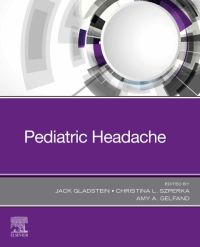Covering the topic of headache in children from the viewpoint of both primary care and neurology, Pediatric Headache provides concise, authoritative guidance on all aspects of this multifaceted subject. Drs. Jack Gladstein, Christina Szperka, and Amy Gelfand, each an expert in pediatric headache, contribute their considerable knowledge and expertise to assist neurologists, pediatricians, and primary care providers in providing optimal care to young patients.
Key Features
-
Offers concise guidance on diagnosis and treatment of pediatric headache from both a primary care and neurologist’s point of view.
-
Covers traditional treatment options such as medication, devices, and behavioral interventions as well as sleep, diet, exercise, and stress management recommendations.
-
Discusses the important issue of patient advocacy for providers and families.
-
Provides support for school-age patients with samples of school letters and other patient material resources for providers to share with families.
Author Information
By Jack Gladstein, MD, Professor of Pediatrics and Neurology, University of Maryland School of Medicine, Baltimore, MD, United States; Christina L. Szperka, MD, MSCE, FAHS, Assistant Professor of Neurology & Pediatrics, Perelman School of Medicine at the University of Pennsylvania, and Director, Pediatric Headache Program, Children's Hospital of Philadelphia, Philadelphia, PA, United States and Amy A. Gelfand, MD, Director of Pediatric Headache, Associate Professor of Neurology & Pediatrics, UCSF Benioff Children's Hospital, UCSF Ron Conway Family, San Francisco, CA, United States
Preface
About the Editors
Acknowledgments
1 My headache appointment: A guide for parents, primary care and specialists
2 You’re not the only one (epidemiology)
3 Pathophysiology of migraine
4 Genetics of migraine
5 The “Episodic Syndromes: i.e. what migraine looks like before it “looks like migraine
5 How did it get so bad?
6 Effect of hormones
7 Chronic migraine and other types of chronic daily headache
8 Comorbidities in children and adolescents
9 NDPH: What a primary care provider/ headache specialist needs to know
10 Post-Traumatic Headaches in Youth
11 POTS and dysautonomia
12 Meds
12 How can I get better?
13 Acute Behavioral Headache Management
14 What should I expect when home therapy does not work
15 Preventive treatments: Oral
16 Preventive Injections
17 Behavioral interventions to improve frequency
18 Devices
19 CGRP
20 Non-medication treatments including acupuncture
20 Behavioral interventions to improve frequency
20 Non-medication preventive intervention, including preventive supplements
20 Things I can do for myself/my child
21 Sleep and Headache in Children and Adolescents
22 Meals/Food/Diet/Caffeine/Hydration
23 Managing Migraines at School including Migraine Action Plan and 504 Plan
23 Activity/Exercise including Yoga
23 Stress management
24 How you can get more involved
24 Managing Migraine at School
25 How you can get more involved: a guide for families and clinicians
26 Spanish Translation of some of these school
26 Growing up: Transitioning to adult care
27 How to set up a headache clinic
28 Where can I learn more? A listing of resources
29 School-age support
30 Lifestyle/enviromental suggestions
34 Advocacy
"This book is very useful as the pediatric population is an undeserved group in headache medicine. The book does a great job of providing information and data on managing headaches in children."
©Doody’s Review Service, 2022, Fred Cohen, MD (Thomas Jefferson University)




